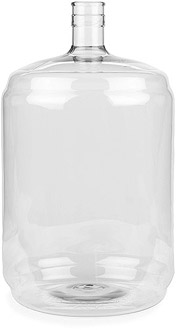 Hello,
Hello,
I’ve heard that plastic carboys can allow oxygen into the carboy during wine brewing or aging. Do you have any knowledge regarding this?
Thank you for your help.
Sonia L.
———-
Dear Sonia,
All the plastic carboys we have seen are perfectly fine for fermenting wine. It’s all about the plastic being used.
In the case of the 5 gallon plastic water bottles, like you see at the grocery store, they are made of food-grade plastic, similar to that used to make milk jugs. Then saran is blown-in to layer the inside as an oxygen barrier.
We sell plastic carboys in various sizes that are made of PET. This is an oxygen-barrier plastic… the same plastic used to make 2 liter soda pop bottles, only these fermenters are much thicker than a 2 liter. It is virtually impossible for oxygen to pass through them.
Happy Wine Making,
Customer Service
———————————————————————————————————
Ed Kraus is a 3rd generation home brewer/winemaker and has been an owner of E. C. Kraus since 1999. He has been helping individuals make better wine and beer for over 25 years.
Category Archives: Q&A
What's That Stuff In My Wine?
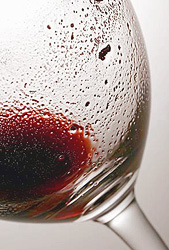 Greetings,
Greetings,
We have been into wine brewing for a few years now but seem to have the same problem every year. Our homemade wine instructions say to let the wine sit for about a year before we bottle it. It is beautifully clear and wonderful tasting. It is a medium sweet grape wine. We get our juice from a local winery. Our problem is when the wine is chilled it gets what I would call residual sugar in it. We have to use a topper with a filter on it to enjoy the wine. Would like to know if you have any opinions on why the wine does this and how we can prevent it.
Thank you
Barbara and Danny
———-
Dear Barbara and Danny,
What you are seeing at the bottom of the wine bottles is not sugar. It is tartaric acid crystals. Tartaric acid is one of many acids found naturally in fruits. Tartaric is the primary fruit acid in grapes.
Essentially, what is happening is your wine has more tartaric acid than it can hold. As the wine gets colder, its capacity for tartaric acid even becomes less. The excess tartaric acid that can’t remain solvent is deposited as little crystals, just like those you are seeing.
This is a fairly common problem when making wine from fresh grapes. It is mentioned in the book, First Steps In Winemaking. You can also read the article, Maintaining Temperature Stability In Your Wines, that is on our website. It will show you how to deal with this issue and how to prevent it in the future.
Best Wishes,
Customer Service at E. C. Kraus
———————————————————————————————————
Ed Kraus is a 3rd generation home brewer/winemaker and has been an owner of E. C. Kraus since 1999. He has been helping individuals make better wine and beer for over 25 years.
What Size Corks Should I Buy?
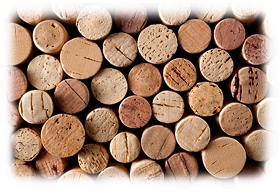 Hi,
Hi,
I ordered a starter kit and some other cool stuff from you, and will be ready to bottle my first batch of wine soon. I would rather use regular corks instead of the plastic top corks in the kit. I have a hodge podge of scavenged wine bottles to use in the 750ml range (or what ever the regular wine bottle is). What size corks would you recommend for this? I didn’t know there were so many different sizes to choose from, and what are the different lengths for?
Thanks,
Paul K.
———-
Dear Paul,
I understand you not wanting to use the Mushroom Corks that are included in the starter kit, particularly if you are planning on giving some of the bottles out as personalized wine gifts. Having a said this, please understand that the Mushroom Corks will seal the wine bottles very well and are appropriate for storing and aging wines for a period of about 12 to 24 months.
To answer your questions, if your wine bottles are standard 750ml and they have a cork finish opening –not screw cap– then the opening should be 3/4 inch. Wineries use a size number 9 cork for this size opening. The 9 refers to the diameter of the cork.
This size cork can not be put in by hand. It is much fatter than the opening of the wine bottle. You’ll have to get a piece of homemade wine equipment called a corker or cork inserter. The corker compresses the cork stopper, then plunges it into the bottle’s opening.
When you buy corks not only do you have a choice of diameter, but you also have a choice of length and grade (density). You may be asking yourself, what’s the difference? The difference is in how much the cork breaths or allows air to permeate through or past it. Longer corks allow less air into the bottle than short corks; dense corks allow less air into the bottle then not-so-dense corks.
Wine needs air to age properly, but too much and the life of the bottle will become to short. Too little air and the wine takes too long to reach its aging potential. In short, you should buy corks that will match the rate of your consumption.
Having said all of this, most people buy either the #9 Superior Grade or the #9 Extra-First Grade (short). If you have a wine that you would like to age for many years, I would suggest getting the Synthetic Corks for the tightest seal.
Happy Wine Making,
Customer Service at E. C. Kraus
———————————————————————————————————
Ed Kraus is a 3rd generation home brewer/winemaker and has been an owner of E. C. Kraus since 1999. He has been helping individuals make better wine and beer for over 25 years.
Time To Bottle, But My Wine's Still Bubbling!
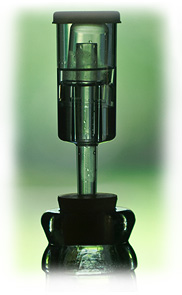 Hello Adventures in Homebrewing,
Hello Adventures in Homebrewing,
I have made wine from kits over 50 times with fantastic success! I have always followed the directions and SG measurements of my hydrometer. I was admiring a finished batch in one of the carboys, getting ready to filter and bottle. To my surprise I noticed the airlock bubble! I watched it and after 7 minutes it did it again. The highly polished finished wine had no bubbling in it or from the lees. Obviously there is some fermentation occurring. Should I rerack the wine into a new carboy and add sodium metabisulfite or what????
Thanks Rich G.
———-
Dear Rich G.,
Glad to hear you’re having such great success with all your wines. People can’t believe how great these wine kits are until they’ve actually tried them.
When it comes to making wine, a good mantra to follow is: When in doubt… wait. Assuming you have a good finishing reading on your gravity hydrometer, I would not do anything but wait some more before filtering and bottling. Just give it more time to make sure the fermentation is complete. You could add a standard dose of potassium or sodium metabisulfite to the wine, but I don’t think it is necessary.
In reality, the fermentation may actually be done even though you are still seeing some bubbling. It could simply be some trapped, leftover CO2 gas from the fermentation that hasn’t been able to release until now.
Temperature change can play a role in this kind of occurrence. If the wine is in glass jugs of sorts, as the temperature cools the glass contracts making the volume it can hold slightly less. The result is a pushing out of some head-space. This is not too noticeable with gallon glass carboys, but when you get to the larger sizes –5, 6 and 7 gallons– it is surprisingly noticeable.
A rise in temperature can also cause some bubbling as well. As a liquid becomes warmer it’s ability to hold CO2 gas become less and less. This is evident when opening a hot can of soda pop versus a cold can. The amount of CO2 gas the froths out is quite different in each instance.
In any event I would just wait it out if I were in your shoes. There’s really no hurry to get the wine into bottles, and realize that the wine is still aging even while it is in bulk.
Great to hear from you.
Customer Service at E. C. Kraus
———————————————————————————————————
Ed Kraus is a 3rd generation home brewer/winemaker and has been an owner of E. C. Kraus since 1999. He has been helping individuals make better wine and beer for over 25 years.
Are Plastic Fermenters Putting A Metallic Taste In My Wine?
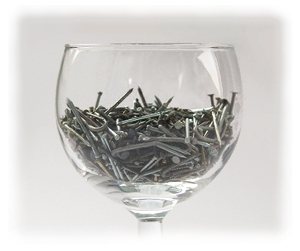 Hi,
Hi,
I am using 5 gal. plastic water bottles purchased new from Target as plastic fermenters. I have had several batches of wine (strawberry/symphony) and just strawberry with a “metallic” twang taste. I have racked off the sediment and was wondering if it was a plastic taste from the water bottles. I noticed that you and other companies do not carry plastic 5 gal “carboys”.
It is just my nature to try and pinch pennies whenever possible. I was just wondering if my penny pinching is hurting my wine making.
Thanks
Don C.
———-
Good Morning Don,
Using a plastic container for fermenting your wine is of no issue at all, just so long as the plastic is food-grade. I’m sure that the water carboys you purchased will work fine as plastic fermenters.
Also just to let you know, we have recently started to carry plastic carboys. We have 3 and 6 gallon sizes. These carboys are made from the same type of plastic used to make 2 liter soda pop bottles.
Going back to the metallic taste in your wine, this is normally caused by leaving the wine on the sediment for too long, particularly after the yeast have ran out of sugars to consume. The yeast will continue their ravaging consumption by eating the dead yeast cells that lay at the bottom. The metallic taste is actually the unique enzymes the yeast will produce to breakdown these dead cells. This is a process called autolysis.
To prevent this from happening in the future you should rack your wine in a timely fashion. Usually this means moving the wine off the sediment sometime around the 5th day of fermentation into a clean secondary fermentation, something like the plastic carboys discussed earlier.
The wine should be racked off the sediment again after the fermentation has completed, and than finely one more time right before bottling. If you plan on aging your wine in carboys before bottling, an additional racking may be necessary.
Happy Wine Making,
Customer Service at E. C. Kraus
———————————————————————————————————
Ed Kraus is a 3rd generation home brewer/winemaker and has been an owner of E. C. Kraus since 1999. He has been helping individuals make better wine and beer for over 25 years.
Do You Have Printable Wine Bottle Labels?
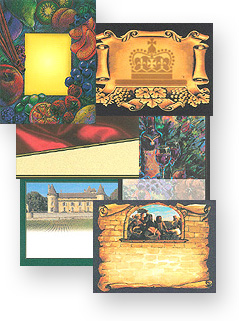 Dear E. C. Kraus,
Dear E. C. Kraus,
I was looking through your wine bottle labels. Can any of them be printed with a computer printer?
Thanks,
Mike
————-
Dear Mike,
Thank you for the great question. If you don’t mind, I would like to share the answer with everyone on our blog.
Currently, we have six different styles of wine bottle labels that can be put through a computer printer for customization. Each style comes four on a sheet, and we sell them in groups of 7 sheets for a total of 28 labels.
Running them through your computer printer is simple. You can use any word processor that your computer may already have on it: Word, WordPerfect, etc. Just type and layout what you want. Use whatever fonts are on your computer. Be creative and have fun!
Print a sample on a white sheet of paper first and hold it over the labels to make sure everything lines up like you want. You may have to make adjustments to what you typed at move it around a bit to get it just like you want.
These printable labels are great for turning bottles of your homemade wine into very personal wine making gifts. Commemorate a family wedding or birth of a grandchild, or you can just pass them out to family and friends as personalized gifts for any occasion.
———————————————————————————————————
Ed Kraus is a 3rd generation home brewer/winemaker and has been an owner of E. C. Kraus since 1999. He has been helping individuals make better wine and beer for over 25 years.
Can I Make Wine In A Stone Crock?
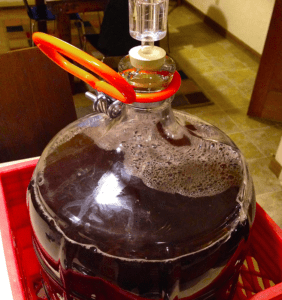 Hello Customer Service,
Hello Customer Service,
If I wanted to use a five gallon crock to make a fermentation happen is that going to be a problem? I do not want to use a plastic fermenter. I am afraid of using any plastics fearing the chemicals used to make the containers will leach into the finished food or wine? What do you think about that?
Thanks Mary
—–
Dear Mary,
It’s okay to use a stone crock for the first few days of the wine brewing, but after the fermentation activity starts to slow down, around the fifth day, you will need to put the wine in a different type of container. One that can have an air-lock attach to it with a rubber stopper. A glass wine carboy works good for this purpose.
The inside glazing of the crock also needs to be free from cracks and chips. These types of damages can not be sanitized sufficiently for a safe fermentation. Mold and bacteria can live in these cracks just waiting for a wine to ruin.
As for using plastic fermenters, what really matters is that the plastic is food-grade. This is the key. Plastics are used to package all kinds of foods. Just look on the store shelves. Everything from lunch-meats to whiskey, to drinking water is stored in plastic.
———————————————————————————————————
Ed Kraus is a 3rd generation home brewer/winemaker and has been an owner of E. C. Kraus since 1999. He has been helping individuals make better wine and beer for over 25 years.
What Do People Make Their Homemade Wine In?
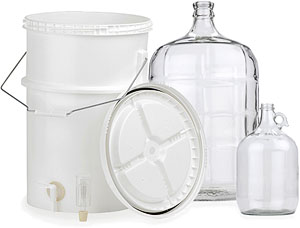 Here’s a email I received from Linda in California this morning. She wants to know what she can use to ferment her plums.
Here’s a email I received from Linda in California this morning. She wants to know what she can use to ferment her plums.
Dear Folks:
Hopefully I won’t sound like an idiot, but what do people make their homemade wine in exactly. I’ve heard it can be done in a trash can. What material is preferable and what alternatives are there? I want to make plum wine, as my two trees here in California have produced a bumper crop. It must be obvious by now, I have no clue. Help?
Thank you–Linda G.
Dear Linda,
Most home winemakers use a plastic fermenter of some sort. A plastic trash can usually would not qualify because the plastic used to make them is not food-grade. The plastic that comes in contact with the wine needs to be of food-grade quality.
Glass water jugs can act as a wine carboy for fermenting. You can also use gallon glass jugs for smaller batches. In general, glass containers are perfectly fine for fermenting.
Please keep in mind that the first few days of fermentation needs to be open or exposed to air. Most people use a food-grade plastic fermenter with a thin towel draped over it. But once the fermentation starts to slow down–around the 5th day–you will need to put an air-lock on the fermenter to protect the wine from wild mold, bacteria and anything else that floats in the air.
The air-lock will need to be fitted to the container with the aid of a properly-sized rubber stopper. The stopper needs to have a small hole in it for the air-lock to fit into. Then the stopper is put into the container’s opening. In the case of a plastic fermenter that uses a lid, you may need to drill a hole into the lid for the stopper to fit into.
———————————————————————————————————
Ed Kraus is a 3rd generation home brewer/winemaker and has been an owner of E. C. Kraus since 1999. He has been helping individuals make better wine and beer for over 25 years.
What Color Wine Bottle Should You Use?
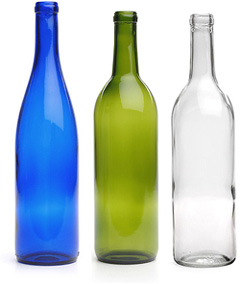 A customer wrote us yesterday and asked, “Does it matter what color of wine bottle I put my wine in?” This is a question we get quite often, so I thought I’d go over the answer here real quick.
A customer wrote us yesterday and asked, “Does it matter what color of wine bottle I put my wine in?” This is a question we get quite often, so I thought I’d go over the answer here real quick.
When bottling homemade wine the only reason the color of the wine bottle would matter is if the wine is left out where it is exposed to light, more specifically, UV rays from the sun, florescent lighting and other UV emitters. These rays can accelerate the oxidation process of your wine.
When bottling homemade wine, the color of the glass will not matter so long as the wine is kept in a dark place. Pick whatever color you like. But if the wine bottles are kept were normal ambient light can get to it, such as in the kitchen, dinning room, etc., you would be wise to use a colored wine bottles. The coloring in the glass will help to filter out much of the UV rays that make their way to the wine bottle.
Oxidation does take time. So don’t think that just because you used clear wine bottles or glass jugs and they’ve been setting out in the light that your wine is ruined. Oxidation is a process that normally takes months, not days or weeks, to affect a wine.
Now that you know, just move your wine bottles to a darker place and remember the next time when you are bottling homemade wine that the bottle color and storage lighting does matter.
———————————————————————————————————
Ed Kraus is a 3rd generation home brewer/winemaker and has been an owner of E. C. Kraus since 1999. He has been helping individuals make better wine and beer for over 25 years.
What Do I Need Along With The Gallon Glass Jugs?
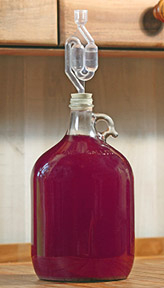 Please remember when you are ordering our gallon glass jugs, that you will need to order closures such as any screw caps or rubber stoppers that may be needed separately. These items are not included with these gallon jugs simply because we do not know what you intend to do with the jugs. Whether your bottling, fermenting or storing wine with them will determine what else you will need.
Please remember when you are ordering our gallon glass jugs, that you will need to order closures such as any screw caps or rubber stoppers that may be needed separately. These items are not included with these gallon jugs simply because we do not know what you intend to do with the jugs. Whether your bottling, fermenting or storing wine with them will determine what else you will need.
For Bottling:
Bottling your wine in gallon glass carboys is a great idea so long as you can consume a gallon of wine in a couple or three days. If you bottle your wine this way you will want to order 38mm screw caps to seal these jugs. For more information on this subject see another post on this blog, Using Glass Gallon Jugs When Bottling Homemade Wine.
For Fermenting:
You can also use the gallon glass carboys for fermenting your wine. For this you will need to attach an air lock to them. This can be done by buying a rubber stopper with a hole in it, and then fit the air lock into that hole. Rubber stoppers come in all sizes, but the ones you will need for these gallon size jugs is a size #6 rubber stoppers.
Alternately, you can use a rubber cap in place of a rubber stopper for attaching an air lock. If you decide to go this route you will want a size #3 rubber cap. Some winemakers prefer the rubber cap over the rubber stopper because it is more difficult for it to accidentally come loose- handy with you have kids or nosy pets.
For Storing:
If you intend to use the jugs for storage or aging, and then bottle the wine later own in regular size wine bottles, then you can use screw caps just as well, but you can also use tapered corks in these jugs for this purpose. A size #14 tapered cork is the size you would want.
The main difference is that the tapered corks will allow some oxygen to permeate through to the wine at a very slow rate. This will facilitate the aging of your wine, causing it to become more mellow sooner. Screw caps do not allow oxygen to pass through.
———————————————————————————————————
Ed Kraus is a 3rd generation home brewer/winemaker and has been an owner of E. C. Kraus since 1999. He has been helping individuals make better wine and beer for over 25 years.
